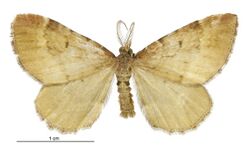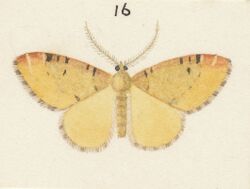Biology:Asaphodes imperfecta
| Asaphodes imperfecta | |
|---|---|

| |
| Male | |
| Scientific classification | |
| Domain: | Eukaryota |
| Kingdom: | Animalia |
| Phylum: | Arthropoda |
| Class: | Insecta |
| Order: | Lepidoptera |
| Family: | Geometridae |
| Genus: | Asaphodes |
| Species: | A. imperfecta
|
| Binomial name | |
| Asaphodes imperfecta (Philpott, 1905)[2]
| |
| Synonyms | |
| |
Asaphodes imperfecta is a moth in the family Geometridae. It is endemic to New Zealand and is found in the southern part of the South Island. The species inhabits low lying swampy native forest. The host plants of the larvae of this species is unknown. The adults are on the wing in December and January. It is classified as critically endangered by the Department of Conservation.
Taxonomy
This species was first described by Alfred Philpott in 1905 as Xanthorhoe imperfecta.[3][4] Philpott used specimens he collected in the West Plains suburb of Invercargill.[4] George Hudson discussed and illustrated this species under that name in 1928.[5] In 1939 Louis Beethoven Prout placed this species in the genus Larentia.[6] This placement was not accepted by New Zealand taxonomists.[7] In 1971 J. S. Dugdale placed this species in the genus Asaphodes.[8] In 1988 John S. Dugdale confirmed this placement.[3] The male holotype specimen, collected at West Plains, Invercargill, is held at the New Zealand Arthropod Collection.[3]
Description
Philpott described A. imperfecta as follows:
29 mm. Head, thorax, and abdomen brownish-ochreous. Fore wings ochreous, in male often reddish on costa and about apex. The usual lines are in the male reduced to irregular blackish costal spots ; in the female these costal spots give rise to very faint transverse waved lines. White spots follow most of the dark costal spots, and there is a fairly conspicuous pair at 2⁄3 ; cilia ochreous, barred with blackish. Hind wings ochreous ; cilia greyish-ochreous mixed with darker. Nearest to X. ceyrota, but easily distinguished by the brighter ground-colour and the white costal spots.[4]
Distribution
Asaphodes imperfecta is endemic to New Zealand.[2][9] The species was regarded as being rare and local to the southern part of the South Island.[5] It is now regarded as being locally extinct in its type locality of Invercargill.[10] George Vernon Hudson mentions that it was also present in Dunedin.[5]
Ecology and habitat
Adult moths had been collected in forest[10] and Hudson stated the species preferred low lying swampy forest habitat.[11] Hudson also stated that adult moths were on the wing in December and January.[11]
Host plants
The host plants of this species are unknown.[12]
Conservation status
This moth is classified under the New Zealand Threat Classification system as being Nationally Critical.[1] It has been hypothesised that this species is under threat as a likely result of habitat loss, given the drying out of ecosystems as a result of wetland drainage which in turn ensures the land no longer supports the plants the species lives on in its larvae stage.[13]
References
- ↑ 1.0 1.1 Hoare, R.J.B.; Dugdale, J.S.; Edwards, E.D.; Gibbs, G.W.; Patrick, B.H.; Hitchmough, R.A.; Rolfe, J.R. (2017). Conservation status of New Zealand butterflies and moths (Lepidoptera), 2015. Wellington, New Zealand: New Zealand Department of Conservation. pp. 5. ISBN 9781988514383. http://www.doc.govt.nz/Documents/science-and-technical/nztcs20entire.pdf.
- ↑ 2.0 2.1 "Asaphodes imperfecta (Philpott, 1905)". Landcare Research New Zealand Ltd. http://www.nzor.org.nz/names/bc43d6a6-6be3-4a4d-9d99-4e76a28c336b. Retrieved 30 April 2018.
- ↑ 3.0 3.1 3.2 Dugdale, J. S. (1988). "Lepidoptera - annotated catalogue, and keys to family-group taxa". Fauna of New Zealand 14: 173. https://www.landcareresearch.co.nz/__data/assets/pdf_file/0017/26324/FNZ14Dugdale1988.pdf. Retrieved 30 April 2018.
- ↑ 4.0 4.1 4.2 Philpott, Alfred (1905). "On some new species of Lepidoptera" (in en). Transactions and Proceedings of the New Zealand Institute 37: 328–333. https://biodiversitylibrary.org/page/3743097.
- ↑ 5.0 5.1 5.2 Hudson, G. V. (1928). The Butterflies and Moths of New Zealand. Wellington: Ferguson & Osborn Ltd.. pp. 121. OCLC 25449322. http://www.bugz.org.nz/WebForms/ResultDetails.aspx?CurrentDoc=C7E94865-492F-45DA-9777-CC8E1E8B1438&back=true&NewDoc=true&searchType=1&SearchString=G.V.+Hudson.
- ↑ Prout, L. B. (1939). "Geometridae: Fauna Indo-Australica". The Macrolepidoptera of the World 12: 264. https://www.biodiversitylibrary.org/page/12779936.
- ↑ , Wikidata Q54670161
- ↑ , Wikidata Q64006453
- ↑ , p. 459, Wikidata Q45922947
- ↑ 10.0 10.1 Patrick, Brian H. (2017). "Ecology and conservation of the rare moth Asaphodes frivola Meyrick". The Weta 47: 17–38. http://publications.ento.org.nz/index.php/weta/article/download/60/57/. Retrieved 30 April 2018.
- ↑ 11.0 11.1 Hudson, G. V. (1928). The Butterflies and Moths of New Zealand. Wellington: Ferguson & Osborn Ltd.. pp. 121. http://www.bugz.org.nz/WebForms/ResultDetails.aspx?CurrentDoc=C7E94865-492F-45DA-9777-CC8E1E8B1438&back=true&NewDoc=true&searchType=1&SearchString=G.V.+Hudson.
- ↑ Patrick, Brian; Dugdale, John S. (2000). Conservation status of the New Zealand Lepidoptera.. Wellington, New Zealand: Department of Conservation. pp. 20. ISBN 0478218672. http://www.doc.govt.nz/documents/science-and-technical/sfc136.pdf.
- ↑ Brian, Patrick (2000). Conservation status of two rare New Zealand geometrid moths. Wellington, N.Z.: Department of Conservation. ISBN 0478219466. OCLC 54078998. http://www.doc.govt.nz/documents/science-and-technical/sfc145.pdf.
Wikidata ☰ Q21244165 entry
 |



